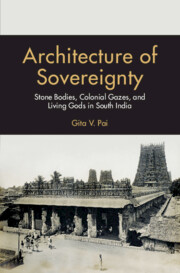Book contents
- Frontmatter
- Dedication
- Contents
- List of Figures
- Acknowledgments
- Notes on Transliteration and Spelling
- Introduction: Sovereignty’s Trace in Architectural Forms
- Part I Stone Bodies
- Part II Colonial Gazes
- Part III Living Gods
- Epilogue: Rejecting the State—Priestly Devotion and Protest in Modern Madurai
- Bibliography
- Index
3 - Imagining Civilization: Antiquarian Curiosities in Madura
Published online by Cambridge University Press: 19 April 2023
- Frontmatter
- Dedication
- Contents
- List of Figures
- Acknowledgments
- Notes on Transliteration and Spelling
- Introduction: Sovereignty’s Trace in Architectural Forms
- Part I Stone Bodies
- Part II Colonial Gazes
- Part III Living Gods
- Epilogue: Rejecting the State—Priestly Devotion and Protest in Modern Madurai
- Bibliography
- Index
Summary
Introduction
The 1792 edition of Archaeologia, the journal of the Society of Antiquaries of London, contained articles on many familiar topics: artifacts discovered at Bath, observations on Canterbury Cathedral, the stalls in Maidstone Church—but the last entry in the issue was an anomalous one. Adam Blackader, a British surgeon working in Madurai (often called “Madura” in colonial records), submitted a letter titled “The Great Pagoda of Madura, and the Choultry of Trimul Naik”—the earliest detailed description of the Mīnākṣī-Sundareśvara temple and its Pudu Maṇḍapam to appear in a British journal, and one of only two Indian architectural subjects recorded by the Society of Antiquaries in the late eighteenth century.
This seminal letter about the temple (labeled a “pagoda” by the British) and its “choultry” (the British name for halls like the Pudu Maṇḍapam), as well as the accompanying drawings and model of the hall, reveal how certain private interests shaped scientific knowledge about India through the formation of academic ‘collections’ in Britain. The Archaeologia issue is one of the first European attempts to analyze the aesthetics of Drāviḍa or south Indian Hindu temple architecture. Blackader's appraisal of the “great choultry of Trimul Naik” contributed to a burgeoning attentiveness towards Indian monuments among wealthy antiquarian enthusiasts during the late eighteenth century that centered on curiosity toward ‘exotic’ native architecture. Scholars in Britain and military and civil servants in British India expressed fascination, admiration, and respect for India—they were nevertheless involved in the process of defining India in such a way that made possible the exercise of power. It was this scientific research that rendered colonization both viable and rational, because ‘India’ became a kind of object that could be rationally analyzed and understood, and thus broken apart, deconstructed, and then reconstructed in the image of the Enlightenment.
Amartya Sen assigned three categories of methods of analyzing India and its traditions. The “exoticist” approach concentrated on the “wondrous aspects” of India, emphasizing what is strange and unfamiliar. The “magisterial” approach related directly to the exercise of imperial power, and is concerned with the cultural superiority of British civilization for the purpose of justifying British paternalism and domination. The “curatorial” approach was the classification and exhibition of diverse aspects of Indian culture, without necessarily prioritizing what is ‘strange.’
- Type
- Chapter
- Information
- Architecture of SovereigntyStone Bodies, Colonial Gazes, and Living Gods in South India, pp. 93 - 121Publisher: Cambridge University PressPrint publication year: 2023



